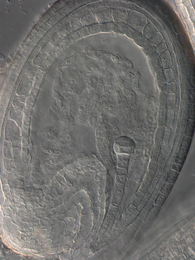Biologists unravel inner dialogue of seeds
Science Publication [12.02.20]
The small miracle that takes place inside plant seeds still holds many puzzles for research. Plant physiologists from the Universities of Hohenheim, Geneva, and Lausanne under the leadership of the University of Lyon have now solved one of these mysteries together: the inner molecular dialogue of seeds. In fact, two genetically different organisms are hidden beneath the seed coat that need to communicate with each other. This has to do with the special reproductive process of flowering plants. The communication of the embryo and the endosperm surrounding it is based on peptide hormones and therefore functions fundamentally differently from most of the plant regulatory mechanisms investigated to date. The scientists involved in the international cooperation project present their results in the current issue of the scientific journal Science.
It was one of the crucial adaptations in the course of evolution that enabled plants to conquer the land: the formation of the cuticle, a wafer-thin, wax-like protective layer with water-repellent properties that prevents evaporation and thus protects leaves and other plant parts from drying out.
The cuticle is formed inside the seed and takes over another function here: it separates the embryo, from which the seedling later develops, from the surrounding nutritive tissue, the so-called endosperm.
Aktuelle Publikation |
N. M. Doll, S. Royek, S. Fujita, S. Okuda, S. Chamot, A. Stintzi, T. Widiez, M. Hothorn, A. Schaller, N. Geldner, G. Ingram (2020): A two-way molecular dialogue between embryo and endosperm required for seed development |
One seed - two organisms
"It is remarkable that the embryo and endosperm are genetically two different organisms. This has to do with the special reproductive path of flowering plants. In contrast to animals, not one fertilization event occurs in this case, but two," explained Prof. Dr. Andreas Schaller, head of the Department of Plant Physiology and Biochemistry at the University of Hohenheim.
In recent years, scientists have found increasing evidence that the two organisms need to communicate with each other inside the seed in order to coordinate their development and control the formation of the cuticle. With the support of researchers from the Universities of Geneva and Lausanne, plant biologists from the Universities of Hohenheim and Lyon have now been able to decipher exactly how this molecular dialogue works and how the process of cuticle synthesis is stopped again.
Plant peptide hormones: Hardly studied, but of central importance

Embryo und Endosperm im sich entwickelnden Samen von Arabidopsis (lichtmikroskopische Aufnahme). Bild: Universität Hohenheim
"From a plant biological point of view, it is particularly interesting that the formation of the cuticle is controlled by a peptide hormone. Peptide hormones are fundamentally different from the classical plant hormones that have been known for a long time. An important property of peptide hormones is that they are formed as inactive precursors and therefore have to be activated by other enzymes before they can exert their effect. Only when the peptide has been suitably 'cut', so to speak, does it fit onto the corresponding receptor and thus trigger a specific reaction. It was only in recent years that researchers discovered the important role peptide hormones play in many regulatory processes in the plant - from fertilization to leaf shedding. Our research team has now succeeded in completely clarifying such a signalling pathway," said the three Hohenheim co-authors of the current Science publication: Prof. Dr. Schaller with Dr. Annick Stintzi and Stefanie Royek.
Cuticle formation: Molecular dialogue with stop mechanism
In concrete terms, the formation of the cuticle in the seed of flowering plants is controlled as follows: the embryo forms an inactive precursor of the peptide hormone TWS1. However, the enzyme ALE1, which is necessary to activate the peptide hormone, is produced in the neighboring endosperm. Initially, the protective layer of the embryo is permeable and the inactive peptide hormones can migrate unhindered into the endosperm. There they are activated and then return to the embryo where they dock to their respective receptors. This triggers the formation of cuticle components, which gradually plug the holes in the protective layer of the embryo and thus further seal the molecular barrier.
"In the end, diffusion between the embryo and the endosperm is no longer possible - i.e. the peptide can no longer reach the activating enzyme, and peptide hormones that have already been activated cannot return to the embryo. The receptors are therefore no longer activated and cuticle synthesis is stopped. The embryo is now protected and ready for germination," said Prof. Dr. Schaller.
Text: Leonhardmair / Translation: Neudorfer